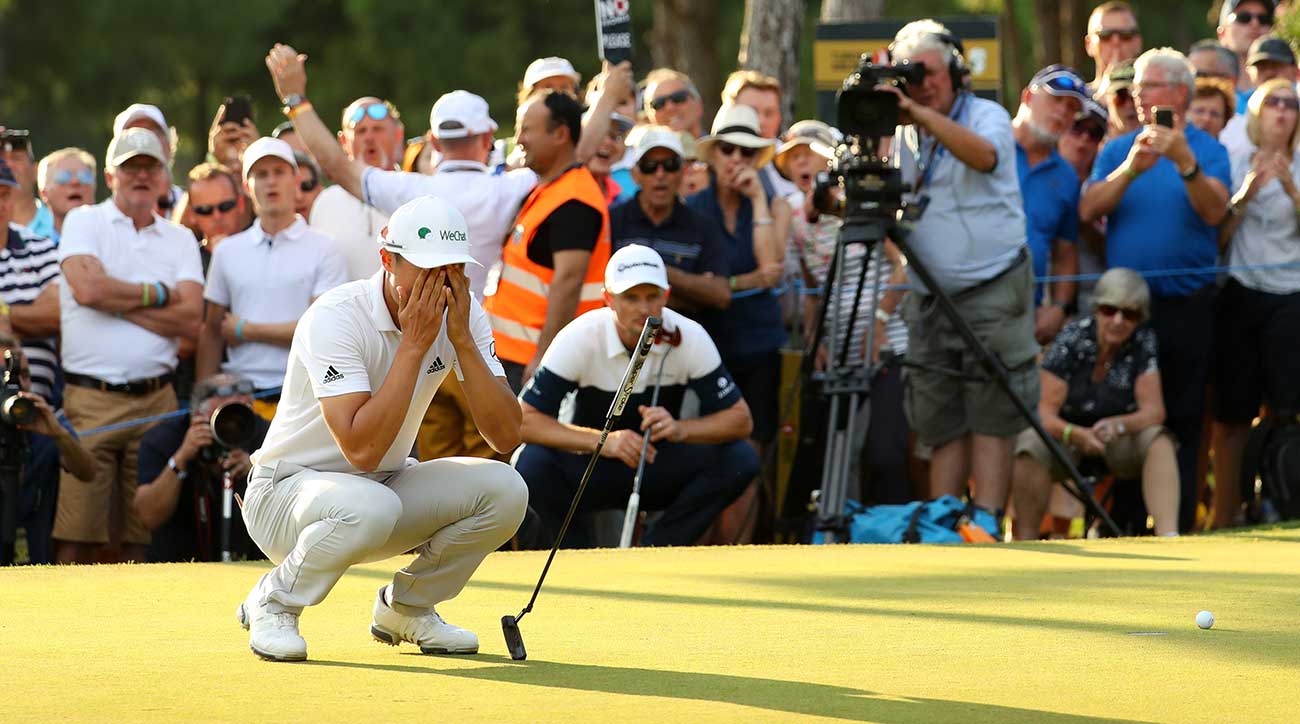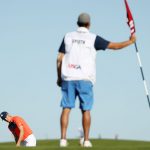Check in every Sunday night for the unfiltered opinions of our writers and editors as they discuss the hottest topics in the sport, and join the conversation by tweeting us @golf_com. Tonight we discuss Bryson DeChambeau’s planned putting attack for 2019, a bizarre DQ at LPGA Q-Series, Hall of Fame criteria and more.
1. Bryson DeChambeau, who won for the third time in his last five starts on Sunday in Las Vegas, told GOLF.com he’s going to putt with the pin in when the Rules of Golf allow for the change beginning in 2019. “It depends on the COR, the coefficient of restitution of the flagstick,” he said. “In U.S. Opens, I’ll take it out, and every other Tour event, when it’s fiberglass, I’ll leave it in and bounce that ball against the flagstick if I need to.” Will this technique actually benefit his game? And do you see many other pros following suit?
Jeff Ritter, digital development editor (@Jeff_Ritter): As someone who has yet to properly study a flagstick’s coefficient of restitution, I feel ill-equipped to state whether or not it’s a winning strategy. But I enjoy the way Bryson continues to cut against the grain. And hey, putting is mostly mental, right? If he believes leaving the stick in will help him, then it probably will.
Josh Sens, contributing writer (@Josh_Sens): So, it’s come to this: we are discussing the coefficient of restitution of the flagstick. I assume he’s done his research, and even if it happens to be ill-founded, as long as HE believes it is helping, I suspect it will.
Luke Kerr-Dineen, instruction editor (@LukeKerrDineen): Bryson will probably be disappointed in my lack of academic notations, but I do think there’s some solid science floating around supporting his conclusion. Leaving the flagstick in the hole effectively has a back-stopping effect. If the ball’s traveling toward the hole at speed, it’ll either clang into the stick and drop in or bounce a few inches away. The flagstick absorbs the brunt of the force; when it’s not there, a fast-moving ball just sort of flies over the hole and keeps rolling. So, yes, it helps around the margins — slightly. But not enough for most people to notice or care.
Dylan Dethier, associate editor (@Dylan_Dethier): Yeah, it may seem like just a quirky fun Bryson story, but I think this is indicative of the approach that has Bryson inside the world’s top five. He’s challenging accepted norms in the hopes of carving just a tiny percentage point off his expected score. Add up all those tiny percentage points and you get one of the hottest players in the game.
Michael Bamberger, senior writer: I think he’s on to something. Except for possible issues of distraction, I’d like to have the flagstick in on downhill putts of virtually any length. It will help more than hurt, over time, I suspect. It’s a game of percentages.
MORE: DeChambeau’s late eagle leads to Vegas victory
2. DeChambeau said he thinks the governing bodies will regret the new flagstick rule — which was created to speed up pace of play — because it will, in effect, make putting easier. “The USGA’s gonna have to go back on that one,” he said. “Like, ‘No! We made the hole bigger!'” Do you think the rulesmakers will want to have this one back?
Ritter: With all due respect to Bryson’s calculations, I’m skeptical that leaving the stick in will make putting noticeably easier. But if it does, I suppose the governing bodies might take another look sometime down the road.
Sens: What’s most interesting to me is how it runs counter to conventional thinking — how many times have we seen pros have their caddies pull the flagstick when they’re trying to hole a chip? You would think the same would apply on a putt. As for repealing, if it really does prove to give undo advantage, it could be repealed easily enough. But these rules aren’t just for pros. And if it is going to quicken the pace of play for all golfers, then I would say that it stays. And I’d be disappointed if it didn’t.
Dethier: Sens is exactly right — what’s most interesting about this approach is how players have been trying for decades to do just the opposite! The possibility of punishing a good shot (a ball rolling at the middle of the hole and doinking off the pin and out, in this case) is a non-starter. But DeChambeau is fantastic at taking human error into account. Still, I don’t see this catching on, at least for a while. Doubt we’ll see a change.
Kerr-Dineen: If the anchor ban provides the precedent, we can deduce that golf’s rules are decided — at least in part — by how the powers that be want the game to look. It’s not something that’s specific to golf. The NFL is a classic example of legislating the game in a way that makes it more marketable. If the bosses upstairs see Bryson putting with the flagstick in and don’t love the look of it, don’t be surprised to see them “revisit” this rule.
Bamberger: The USGA created the rule for us, not for them. The USGA might realize the rule works for us, and not for them. And this would give the USGA a chance to create a different set of rules for elite players and ordinary players. And that, if done sensibly, would be good for golf.

3. Doris Chen, the 2014 NCAA champion at USC, was penalized and eventually disqualified from the LPGA’s Q-Series when she hit a ball that was previously moved by an outside agency from out of bounds back into play. Chen and her caddie were told the ball had been moved, but they played it anyway, which led to a penalty. But because Chen didn’t penalize herself before teeing off on the next hole she was disqualified for a breach of Rule 15-3b. Making this story all the more bizarre are the reports of who moved Chen’s ball: her mother. Where does this episode rank in the pantheon of crazy rules episodes? And should Chen face more repercussions beyond just the DQ?
Ritter: It’s one of the most bizarre rules situations I’ve ever encountered. There are still a couple of dots to connect here before determining further punishment. The big one: It’s reported that Chen knew her ball had been moved, but did she know it was kicked in bounds by her own mother? If that is proven to be the case, further punishment is warranted.
Sens: Anyone who follows competitive junior golf knows that allegations of parents and other relatives using foot wedges from the gallery are nothing new. So I’m not sure I’d call this especially bizarre. But it is unfortunate. I remember a seagull picking up Brad Faxon’s ball and dropping it in a water hazard. No penalty under the rules. But still a pretty whacky moment.
Kerr-Dineen: This HAS to be the weirdest golf rules saga in recent years — and that’s saying something. I mean, I don’t know. It’s all so weird and confusing and I get strange vibes from all of it. I just miss the old days, when we could decide the fate of a U.S. Open by discussing whether the ball moved inadvertently or not.
Dethier: What makes it particularly bizarre is that it was in the midst of golf’s most bizarre tournament in recent history: the 144-hole LPGA Q-Series. That’s a hell of a pressure cooker, and it sounds like desperation got the better of Team Chen. I think it will be hard to get beyond “he-said, she-said.” But the idea of a dialed-in neighbor defending the Rules of Golf is particularly delicious. Mike Davis should award this onlooker with some sort of service award.
Bamberger: At that level of the game? The device by which one can measure the level of oddness of this rules debacle does not yet exist. If mother was acting on her own, there should be some kind of restraining order on her, in terms of attendance at golf tournaments. If mother and daughter are in cahoots, one simple DQ is not nearly enough of a penalty.

4. With a win in Turkey, Justin Rose took back the World No. 1 ranking from Brooks Koepka, marking the sixth time since May that the crown has exchanged hands. Does this musical-chairs act in any way devalue the significance of attaining this title?
Ritter: Nah, right now you’ve got a small handful of guys who have played fantastic for a couple of years, and they just happen to have a similar number of ranking points. No. 1 remains one of golf’s most exclusive clubs and a tremendous accomplishment.
Sens: It definitely points to the parity near the top of the game and reminds us how streaky the game can be. Maybe we take a page from “Zoolander” and call it the “Hansel, he’s so hot right now award.” To answer more directly, though, yes. It definitely takes away some of the luster. It’s always more prestigious when the champ grabs the belt and holds on to it, long and tight.
Kerr-Dineen: This isn’t anything against Justin Rose, but I’ve been of the opinion for a while that the Official World Golf Ranking is far too volatile. This development does nothing to change my mind. World rankings are supposed to be somewhat insulated from various peaks and troughs of form, which is important in a streaky sport like golf. Jordan Spieth’s rankings history is a good example. The week before the 2015 Masters, when Spieth had zero majors and one PGA Tour win, he ranked 4th in OWGR. He’s won nine times since then, including three majors, but somehow now ranks — 13th?! Is Spieth really only the 13th-best player in the world, and worse than he was almost four years ago? No, he’s not. He’s a victim of a system that’s more focused on illustrating form than ability. It’s a glorified power ranking.
Dethier: Disagree with my man LKD here. The World Ranking SHOULD be volatile right now because it’s not clear exactly who the world’s best player is at the moment. Rose has been indomitable, but I’ve suspected for a while that we’re entering the reign of King Koepka. And that’s ignoring DJ, JT and a hard-charging Bryson. But if you’re a fan of No. 1 upheaval, I’ve got more good news: Regardless of what happens next week, the math shakes out that Koepka will take back that top slot anyway. Go figure!
Bamberger: The musical chairs of late is a further demonstration of the dominance not just of Tiger Woods, because that’s obvious, but also, in an earlier time, Greg Norman.

5. World Golf Hall of Fame CEO Steve Mona defended the Hall’s selection criteria in an interview with Reuters, saying, “It’s not just strictly [based] on playing record. The Fame element is part of it. Some people were just more popular than others when they were on tour.” Should the level of fame one achieves in the game be a contributing factor for enshrinement?
Ritter: I want to say no, but that’s not realistic. I think one way to measure a candidate is to ask the question, “Is this person critical to the story of the game of golf?” Celebrity is part of it. It has to be.
Sens: Something as subjective as “fame” or popularity seems like an odd measuring stick. This isn’t a vote for homecoming king and queen.
Kerr-Dineen: I mean, sure, I get that. But it’s also true there are lots of ways to contribute to the game of golf, and not necessarily on the course. The World Golf Hall of Fame can and should recognize that, but even so, that doesn’t account for the key issue: That the Hall of Fame is too easy to get in to. Only when the Hall of Fame starts being OK with leaving out the good-not-great players will it be truly fixed.
Dethier: Only if “Fame” was a crucial part of that person’s career. Legendary swing coach, influencer, thought leader in the game? Sure, fame means something. But it shouldn’t be an important part of the calculus in a playing career.
Bamberger: It is, of course, called a Hall of Fame, so on that basis alone, Mona’s point is reasonable. I know Mona used the word fame, but I think he was really going for impact.
6. In a nod to Bryson, our Josh Sens detailed nine other rules modifications that will make the game more user-friendly in 2019. Which of these amendments do you think will most benefit weekend golfers?
Ritter: As someone prone to hitting balls into, uh, “interesting” locations, I like the lost ball rule: take a two-shot penalty, take a drop and keep play moving.
Bamberger: I agree, Jeff, but the two shots is one shot too many.
Sens: I know not many casual golfers abide by it anyway, but the local rule that allows you to just drop laterally after a lost ball rather than going back to the original spot — that’s both a potential shot saver and a definite time saver.
Kerr-Dineen: Hands down the “being able to tap down spike marks” rule. Nothing worse than a good putt deflecting wildly off line through no fault of your own.
Dethier: If everyone stuck to it, the “40 seconds or less” rule would just about change the world.







